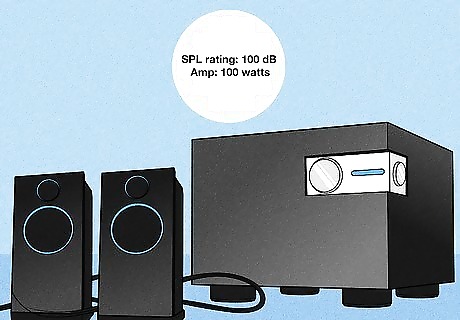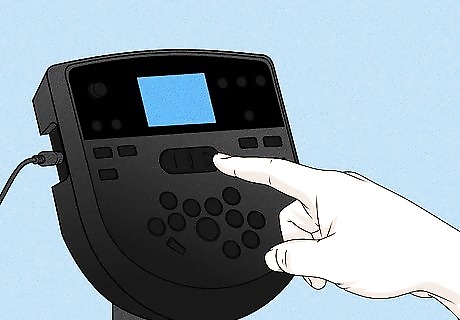
views
Purchasing a Sound System

Decide if you want to use an amplifier or a PA system. You can amplify an electric drum kit using either an amp or a PA system. There are pros and cons to both options. Amplifier: Amplifiers tend to be more affordable. They are specifically made for electric drums. They are capable of pushing a wide range of frequencies, so the low kicks sound just as good as the high cymbals. An amp is a good option if you are practicing at home or in a practice area. PA System: A PA system is a bit more expensive. The bass may not sound as good as on an amp (unless you purchase an additional subwoofer). A PA system has a mixer with multiple inputs. This allows multiple instruments or microphones to be connected at the same time. You can also connect a mobile phone or laptop computer to a PA system. A PA system can also push louder volumes than most electric drum amps. You can also connect both the left and right inputs of your electric drum kit module to a PA. This allows you to take advantage of different panning options. A PA System is a good option if you are practicing with a band and/or performing in small to mid-sized venues.

Consider how much volume/power your sound system needs. Generally, a speaker system that is capable of pushing more wattage is capable of louder volumes. However, you must also consider the sensitivity of the speakers. This is referred to as the sound pressure level (SPL). This rating explains how much wattage the system converts to sound. A sound system with an SPL rating of 100 decibels (dB) will require an amp of at least 100 watts. However, a sound system with an SPL rating of 112 decibels will require at least 1600 watts. Consider your needs. You probably won't need that much power if you are playing in your own personal practice area. However, if you are playing for an audience or you play in a death metal band, you'll probably need more power.

Consider an amp or powered speaker. An amp or powered speaker is a self-contained unit that has a speaker, one or two instrument inputs, a volume knob, and EQ knobs that allow you to adjust the low, high, and mid-range frequencies. You can connect your electric drum module directly into the amp or powered speaker unit. Amps and powered speakers generally cost anywhere between $100 - $400 dollars. Most electric drum kit manufacturers also make amps that are specifically made for their products, but you can also use amps made from other manufacturers. If possible, go to a music shop and try out different electric drum amps to see what you like. If you can bring your drum kit (or at least part of it) with you, even better. This will let you sample what the amps sound like with your electric drum kit. Guitar and bass amps may not be suitable for an electric drum kit. Guitar and bass amps are designed for a specific frequency range. The lows and highs may not sound as good. Keyboard amps may be suitable for electric drums. They are designed to handle a wide range of frequencies, which is needed for the low kicks and high cymbals.

Consider a PA with active speakers. A PA with active speakers consists of a mixer that connects to two powered speakers. Your electric drum kit will connect to the PA mixer. Then the mixer connects to a pair of speakers, which have their own built-in amplifier.

Consider PA with an amplified mixer and passive speakers. With this speaker sound system, your electric drum kit connects to the mixer. The mixer has a built-in amplifier that provides power to the speakers. A pair of passive (non-powered) speakers connect to the mixer. Check the power output of the mixer and the capability of the speakers. If your powered mixer is capable of pushing 1000 watts, but your speakers can only handle 500 watts, you may damage your speakers. Likewise, if you have a low-powered mixer, it will reach clipping levels much quicker than a higher-powered mixer. This can damage higher-powered speakers that aren't rated for that mixer. It's also important to check the RMS Watt rating on a speaker and compare it to the Peak Watt rating. The RMS Watt rating is how much continual power usage a speaker can handle. The Peak Watt rating is the maximum power output a speaker system can handle in short bursts. Many companies advertise their Peak Watt ratings because bigger numbers are more impressive. However, a speaker that has a 150 Peak Watt rating may be no better than a speaker that has a 75 RMS Watt rating.

Consider a passive speaker with an external amplifier PA system. This type of system uses a non-amplified mixer that connects to an external amplifier. A pair of passive (non-powered) speakers connect to the amplifier. This is the most complex setup and is probably not necessary for most private practice situations. However, if you own a live music venue, this may be a good option for your permanent sound system. As with a powered mixer setup, make sure the power output of the amplifier matches the power capabilities of the speakers. Also, check the RMS and Peak Watt ratings of the speakers.
Installing the Sound System

Arrange your equipment. Place the speakers on the left and right sides of the stage or practice area. If you are on a stage, make sure the microphones are placed behind the speakers. If you are in a practice area and need to hear the speakers, make sure the microphones are facing away from the speakers. Don’t plug anything into a power source until all of the equipment is connected via cables.

Connect the speakers and amplifiers to your PA system. If you are using a PA system, use a ¼ inch cable or XLR cable to connect the mixer output to the speakers, or to the external amplifier. Then connect the external amplifier to the speakers using another cable. Make sure everything is powered off while you are setting it up. Most output jacks take ¼ inch cables. However, some PA systems allow you to connect to it using an XLR cable. An XLR cable can be very long and doesn't lose signal quality. ¼ inch cables can lose signal quality after so many feet.

Find the module output jack on your drum set. Locate the drum module. This is the “brain” of the drum kit that allows you to alter the sounds, change the settings, and turn the kit on and off. Look around the module for a port labled "Output," "Audio Out," or similar. This is where you’ll connect the drum kit to the amp or PA system. Do not connect to the headphone port unless there is no other option. If your module has two separate outputs for left (L) and right (R), connect to the left one for mono sound. Only connect to the right (R) output if you want to use both the left and right outputs for a stereo sound.

Connect your drum module to your speakers or PA system. Use long, ¼ inch cables or XLR cables. First, plug one end of the cable into the output jack of your drum set and the other end into the input jack of your amplifier or one of the channel inputs on the PA mixer. If you’re using an active speaker, use a ¼ inch cable to connect the drum module’s output jack and the speaker’s input jack or the mixer directly to the speaker. Some venues may have a direct input box on stage that you can connect to. This is a box with an input port that connects directly to the mixer.

Power on the amplifier or PA system. First, make sure the master volume and gain on the mixer are turned all the way down. Plug in the amplifier or PA and speakers. Then go ahead and power on the speaker or the external amplifier.

Test the sound. Go ahead and play your drums. Make adjustments to the volume and gain levels on your module and amp or PA system until you are at a reasonable volume level. Make sure your gain levels are low enough that it sounds clean, but still produces a sharp sound. The sound can be adjusted from the drum module, the speakers, or the amplifier.
Improving Your Sound

Adjust the settings on your drum module. Most drum modules allow you to control the different tones that your drum set creates. You can alter the volume of the low and high notes or change the timbre of the notes by “changing” drum sets. Cycle through the different drum types to imitate a variety of popular higher-end acoustic drums. Consult the users manual for your electric drum module to learn more about how to change the drums and different sounds on it. If you purchased an inexpensive drum kit, these features may not be available. If you still don’t like the sound of your drum set, consider upgrading the module. Purchase a higher-quality version from the same brand to replace your old module.

Use a mixer or EQ settings on the amp to adjust the sound. Most amps have at least 3 EQ knobs labeled "Low," "Mid," and "High." This allows you to adjust the frequency of your tone. If you want more bass, turn up the Low. If the cymbals are too loud, turn down the high. If you want more snare and toms, turn up the mid. A mixer may have even more options in between "Low", "Mid" and "High." Generally, the EQ knobs or slider bars that control the lower frequencies are on the left, and the higher frequencies are on the right.

Consider adding effects. You can further enhance your sound using effects. Different effects may be built-in to the module, the amplifier, mixer, or added using an effects board that is connected between the module and the amplifier. Some effects include the following: Reverb: Reverb is an echo-like effect that emulates the sound of playing in different sized rooms. It emulates sound bouncing off walls. Delay: Delay is another echo-like effect where the sound actually repeats after it is played. You can adjust the speed at which it repeats, the volume, and how many times it repeats Gain: Gain adjust the volume of a sound wave right after it goes through the input. It's the first process a sound wave goes through in a mixer. Adding too much gain can cause distortion. Distortion: Distortion is any effect that purposely distorts or corrupts the audio signal. This is generally used to make your instrument sound dirtier or rougher.


















Comments
0 comment